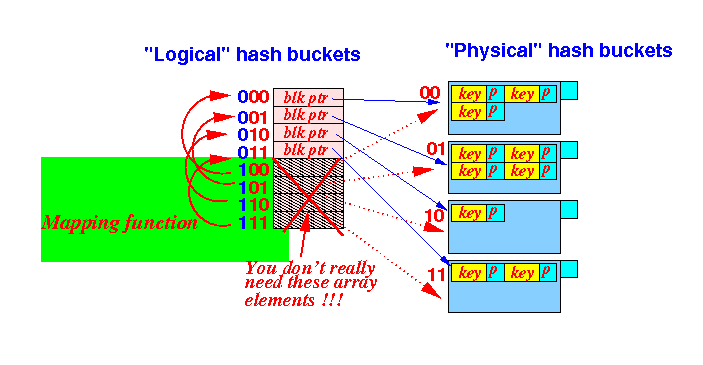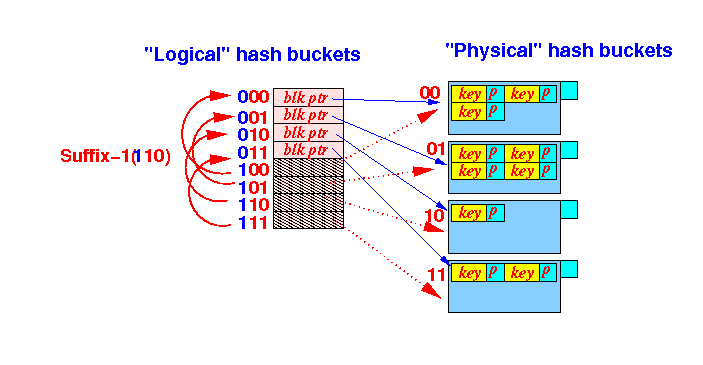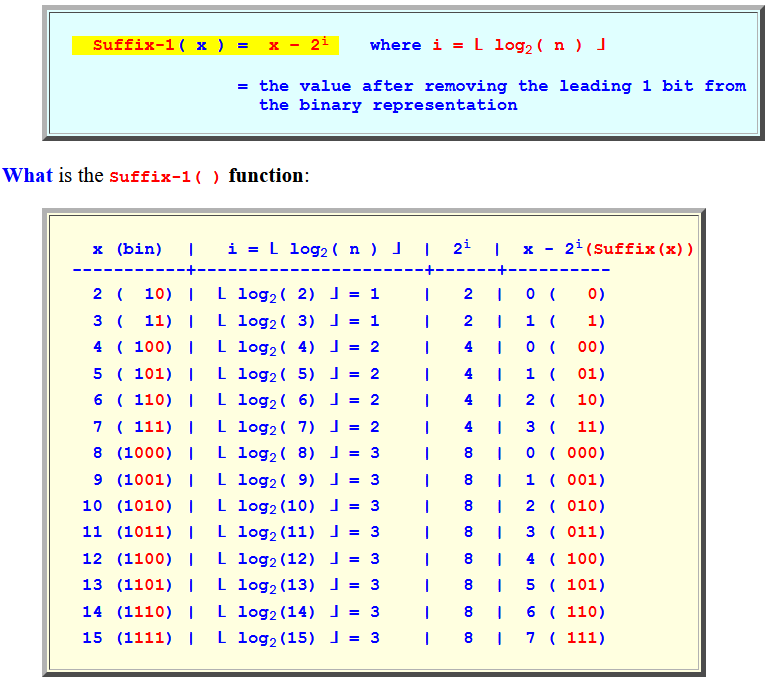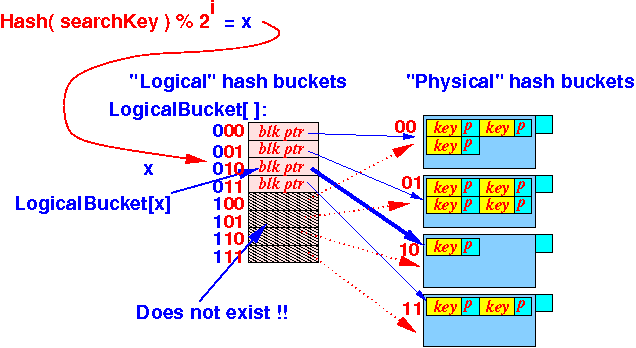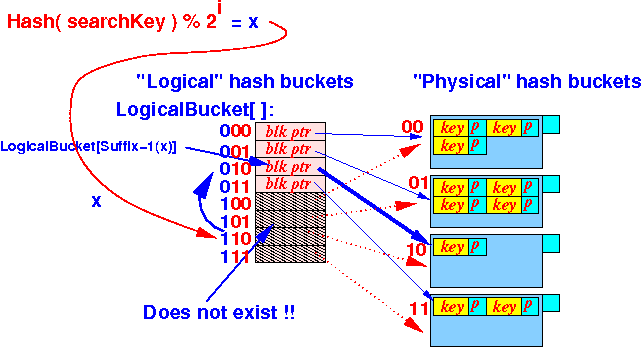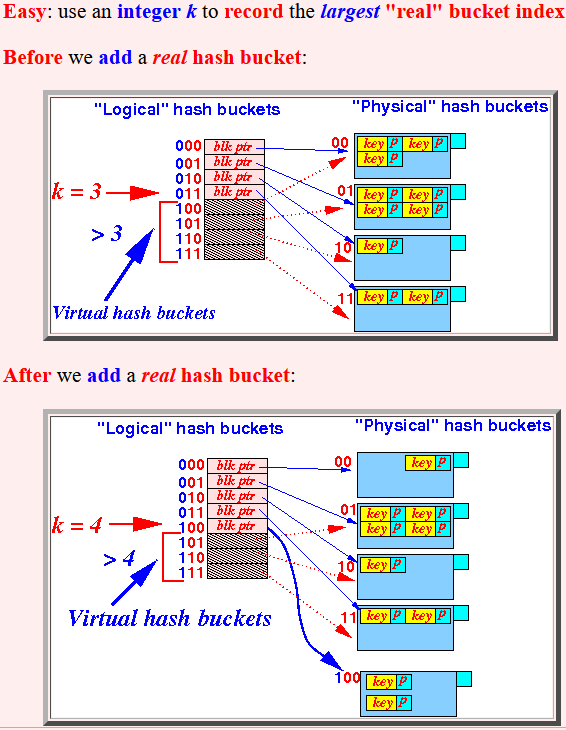Slideshow:
- Main
disadvantage of
Extensible Hashing:
- The size of the
bucket array
will double each time
the
parameter i
incresses by 1
- This exponential growth rate is too fast
- The size of the
bucket array
will double each time
the
parameter i
incresses by 1
- Properties of the
Linear Hashing technique:
- The growth rate of
the bucket array will be
linear
(hence its name)
- The decision to
increase the
size of the
bucket array is
flexible....
A commonly used criteria is:
- If (
the average occupancy per bucket
>
some threshold
) then:
- split one bucket into two
- If (
the average occupancy per bucket
>
some threshold
) then:
- Linear hashing must use overflow buckets ..... (will have higher search overhead than Extensive Hashing --- no free lunch !!!)
- The growth rate of
the bucket array will be
linear
(hence its name)
-
Recall the
bucket doubling
technique
used in
Extensible Hashing:
- Before
doubling
the logical hash table:
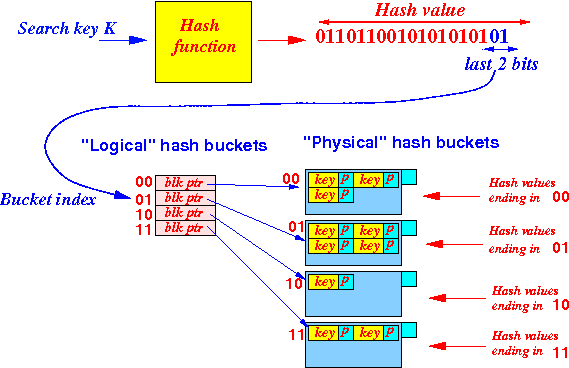
- Extensive Hashing allow us
to increase (= double)
the hash function range
(= table size)
After doubling the logical hash table:

- Before
doubling
the logical hash table:
- Notice that:
- We increased the
hash function range
by
implement:
- A mapping of new hash keys in the additional range to the physical hash table
Graphically:
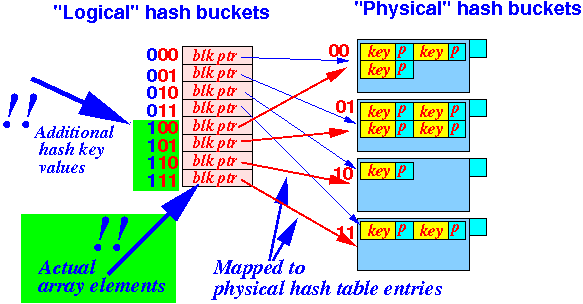
Idea:
- Do not use
real
hash buckets (= array elements)
- Use virtual hash buckets:
- Virtual bucket = a number that represents a hash bucket
- We use a mapping function
to map the
virtual hash buckets to
a physical hash bucket

The mapping function in the above example is as follows:
100 ⇒ 0 101 ⇒ 1 110 ⇒ 10 111 ⇒ 11 Or: 100 ⇒ 00 101 ⇒ 01 110 ⇒ 10 111 ⇒ 11
- We increased the
hash function range
by
implement:
- Define the following
mapping function:
Suffix-1( x ) = x − 2i where i = ⌊ log2( n ) ⌋ = the value after removing the leading 1 bit from the binary representationWhat is the Suffix-1( ) function:
x (bin) | i = ⌊ log2( n ) ⌋ | 2i | x - 2i(Suffix(x)) -----------+----------------------+------+---------- 2 ( 10) | ⌊ log2( 2) ⌋ = 1 | 2 | 0 ( 0) 3 ( 11) | ⌊ log2( 3) ⌋ = 1 | 2 | 1 ( 1) 4 ( 100) | ⌊ log2( 4) ⌋ = 2 | 4 | 0 ( 00) 5 ( 101) | ⌊ log2( 5) ⌋ = 2 | 4 | 1 ( 01) 6 ( 110) | ⌊ log2( 6) ⌋ = 2 | 4 | 2 ( 10) 7 ( 111) | ⌊ log2( 7) ⌋ = 2 | 4 | 3 ( 11) 8 (1000) | ⌊ log2( 8) ⌋ = 3 | 8 | 0 ( 000) 9 (1001) | ⌊ log2( 9) ⌋ = 3 | 8 | 1 ( 001) 10 (1010) | ⌊ log2(10) ⌋ = 3 | 8 | 2 ( 010) 11 (1011) | ⌊ log2(11) ⌋ = 3 | 8 | 3 ( 011) 12 (1100) | ⌊ log2(12) ⌋ = 3 | 8 | 4 ( 100) 13 (1101) | ⌊ log2(13) ⌋ = 3 | 8 | 5 ( 101) 14 (1110) | ⌊ log2(14) ⌋ = 3 | 8 | 6 ( 110) 15 (1111) | ⌊ log2(15) ⌋ = 3 | 8 | 7 ( 111)Conclussion:
Suffix-1(x) returns the suffix of x after removing the leading 1 bit from x Suffix-1( 10 ) = 0 Suffix-1( 11 ) = 1 Suffix-1( 100 ) = 00 Suffix-1( 101 ) = 01 Suffix-1( 110 ) = 10 Suffix-1( 111 ) = 11 Suffix-1( 1000 ) = 000 Suffix-1( 1001 ) = 001 Suffix-1( 1010 ) = 010 Suffix-1( 1011 ) = 011 ...
- How to
use the
Suffix-1( ) function
to
map
the virtual
logical hash buckets to
physical hash buckets:
- Let
x =
the logical hash function value
obtained by
hashing a
search key
- x = a logical hash bucket index
- If
bucket x is
not virtual then use
the block pointer
to locate the
physical
hash bucket (= data block):
LogicalBucket[ x ] - If
bucket x is
virtual then use
the following (computed/mapped)
block pointer
to locate the
physical
hash bucket (= data block):
LogicalBucket[ Suffix-1( x ) ]Graphiscally explained:

- Let
x =
the logical hash function value
obtained by
hashing a
search key
- Suppose we
are currently using
the last 2 bits
of the hash value:
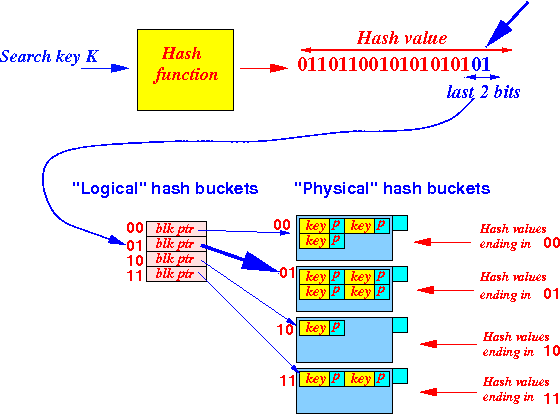
- Suppose we
double the
logical hash buckets
by using
the last 3 bits of
the hash value:
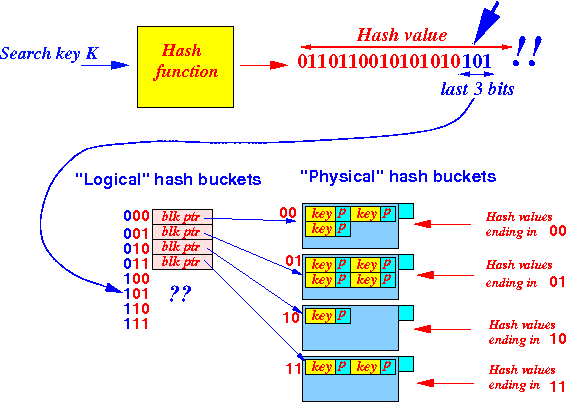
We can locate the search key in the hash index using the Suffix-1( ) function as follows:

Note:
- The logical hash table
still has
4 array elements
I.e.:
- We do not have to double the array size to fix the change in hash function range !!!
- The logical hash table
still has
4 array elements
- What happens in
Linear Hashing when we make a
virtual (logical) hash bucket
into a
"real" (logical) hash bucket:
- Before:
the logical hash bucket 100
is virtual:

- If
the logical hash bucket 100
becomes an actual array element
(= non-virtual), then
it will
point to
a (new) physical hash bucket:

Where:
- The new physical hash bucket (disk block) will be used to store search keys that hash to 100
Notice that:
- Some of the search keys that hash to 100 are (still) stored in the physical hash bucket 00 !!!!!
- Solution:
- Re-hash all the
search keys in
bucket
Suffix( 100 )
(= bucket 00)

- Re-hash all the
search keys in
bucket
Suffix( 100 )
(= bucket 00)
- Before:
the logical hash bucket 100
is virtual:
- How to tell
if a bucket is
real/virtual:
- Easy:
use an integer k
to record the
largest
"real" bucket index
Before we add a real hash bucket:
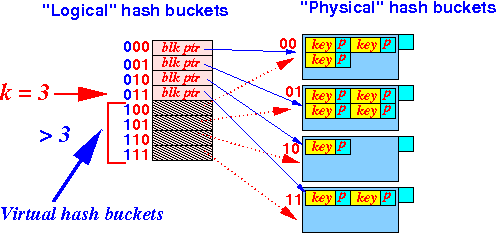
After we add a real hash bucket:
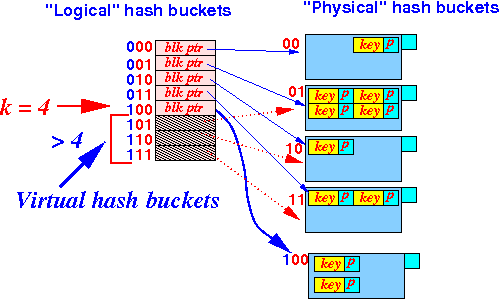
- Easy:
use an integer k
to record the
largest
"real" bucket index



